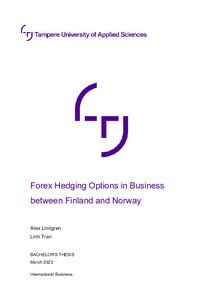Forex hedging options in business between Finland and Norway
Lindgren, Alex Valtteri Jr; Linh, Tran Nguy My Jr (2023)
Lindgren, Alex Valtteri Jr
Linh, Tran Nguy My Jr
2023
All rights reserved. This publication is copyrighted. You may download, display and print it for Your own personal use. Commercial use is prohibited.
Julkaisun pysyvä osoite on
https://urn.fi/URN:NBN:fi:amk-2023051811621
https://urn.fi/URN:NBN:fi:amk-2023051811621
Tiivistelmä
The objective of this paper was to propose an ideal solution to optimize the case company's profits and to avoid transactional losses in the Norway market. To archive this, various available hedging methods were provided to make additional comparisons with the existing method that is used by the case company presently.
The research applied both qualitative and quantitative methods. The primary data was the case company's transactions in 2021 and 2022, while the secondary data was semi-structured interviews with the case company's financial department employee and the bank expert.
This thesis discusses the fluctuating currency exchange rates that might have significantly affected the company's financial performance and explores various hedging methods to manage this risk. Throughout the case analysis, the most challenging for the case company was finding an optimized currency protection plan to improve the company's competitiveness in the Norwegian market. Furthermore, in many cases, unexpected delays in the project led to a significant increase in covering costs for the case company, which was also a primary reason that decreased the case company's revenue.
The authors suggested several recommendations for various circumstances; nevertheless, the most practical long-term solution for the case company was to use the option contract and persuade customers to split the premium fee. The currency exchange risk could not be eliminated, it merely changes the belonging sides, and in the present situation, it would likely move onto the customers' side. This suggested approach would allow the company to hedge against exchange rate fluctuations to mitigate risks and provide beneficiary results to both parties, which might be a plus point to increase interest in the Norwegian market.
The research applied both qualitative and quantitative methods. The primary data was the case company's transactions in 2021 and 2022, while the secondary data was semi-structured interviews with the case company's financial department employee and the bank expert.
This thesis discusses the fluctuating currency exchange rates that might have significantly affected the company's financial performance and explores various hedging methods to manage this risk. Throughout the case analysis, the most challenging for the case company was finding an optimized currency protection plan to improve the company's competitiveness in the Norwegian market. Furthermore, in many cases, unexpected delays in the project led to a significant increase in covering costs for the case company, which was also a primary reason that decreased the case company's revenue.
The authors suggested several recommendations for various circumstances; nevertheless, the most practical long-term solution for the case company was to use the option contract and persuade customers to split the premium fee. The currency exchange risk could not be eliminated, it merely changes the belonging sides, and in the present situation, it would likely move onto the customers' side. This suggested approach would allow the company to hedge against exchange rate fluctuations to mitigate risks and provide beneficiary results to both parties, which might be a plus point to increase interest in the Norwegian market.
